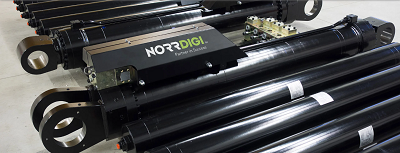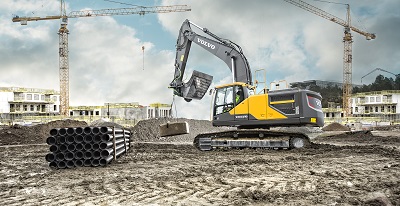Volvo Construction Equipment and Finland’s Norrhydro have developed a digital hydraulic actuator that reportedly boosts productivity while radically cutting fuel bills and CO2 emissions in construction applications. If widely adopted, it could help the mobile-equipment industry meet its sustainability ambitions while at the same time revolutionize machine hydraulic performance.

While the full details of the technology are closely guarded, the Norrhydro patented system, NorrDigi, uses a multi-chamber digital hydraulic actuator that improves system efficiency such that much of a machine’s hydraulic system can be discarded or downsized. It removes the need for a main control valve, reduces the necessary pump capacity, and eliminates a number of hoses and tubing.
Ongoing validations of the system have demonstrated both efficiency improvements and increased productivity, as well as a sizeable reduction in the machine’s carbon footprint. The companies have signed a multi-year agreement where Volvo CE will continue to develop the technology in partnership with Norrhydro, and subsequently aim for first-mover advantage. Volvo CE has exclusive rights to its use in its products during the development process.
Variable cylinders
Unlike traditional cylinders with two chambers — one pushing and the other pulling — the digital hydraulic actuator uses four chambers that can be connected in up to 16 different permutations, depending on the load required by the desired operation.
“It’s a bit like a 16-speed linear transmission,” said Peter Stambro, Vice President Business Development at Norrhydro. “Multi-chamber cylinders have been around for a while, but what makes our ones exceptional is the way they have been combined with advanced electronic control systems, whose complex algorithms and computational speed allow instant response, but using only a fraction of the energy for the same machine maneuver or action compared to a traditional system.”

The NorrDigi’s 16 area combinations and advanced control system in effect makes it a variable-displacement cylinder. Among the main benefits of the digital hydraulics system, it uses less flow than a conventional system, which means that hydraulic pumps can be downsized. The system can share energy between functions through a common pressure rail, so the prime mover doesn’t need to run continuously (engine-off). It can recover and store energy in accumulators (or batteries) with up to 80% efficiency. And the system generates less heat, which means that the hydraulic cooler may be smaller or possibly eliminated
Because the system uses less energy, the power source (engine, battery or electric motor) can be downsized. For electric vehicles, it can significantly extend service time between charges. And for traditional machines, the engine can be run at optimum speed, which has a significant impact on both noise and emissions.
The system is said to be particularly efficient in applications with high inertia loads, both linear and rotary, such as lowering or braking. The results are significant. Fuel efficiency improvements by 45 to 60% and productivity increases of up to 12% were achieved in side-by-side trials with experienced operators.
Field tests
“This is a prime example of how partnerships with outside experts can accelerate our own sustainability journey through technical innovation,” said Thomas Bitter, Head of Technology at Volvo CE. “In research so far, the system shows greatest benefits in larger machines – in the case of excavators, those 30 tons and above. However, in the future, the technology could also be used in electric machines, where its much greater hydraulic system efficiency would effectively extend the battery life and operating window,” he said.
With a Volvo EC300E 30-ton excavator as a test bed, the ground-breaking technology has passed its initial proof-of-concept phase and durability tests, and is now moving to field tests, where prototypes are used in real-world applications by selected customer partners. It is forecast that the system will be offered on the company’s excavators by 2024 at the latest.
“The ability to develop this radical technology in partnership with a leading player in the construction equipment industry offers many advantages, including accelerating the time to market for commercialized products,” said Yrjö Trög, CEO of Norrhydro. “We will invest in a new multi-million euro world-class manufacturing facility in support of the launch, and I look forward to the market introduction of the NorrDigi system together with Volvo CE.”
Norrhydro
www.norrhydro.com
Volvo Construction Equipment
www.volvoce.com
Filed Under: Mobile Hydraulic Tips, News